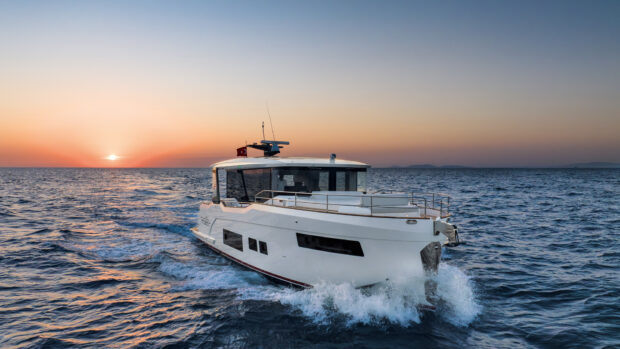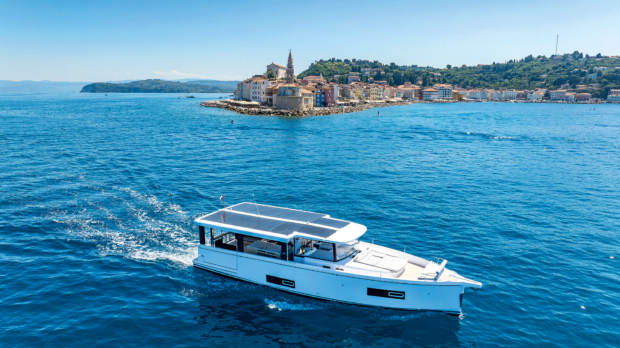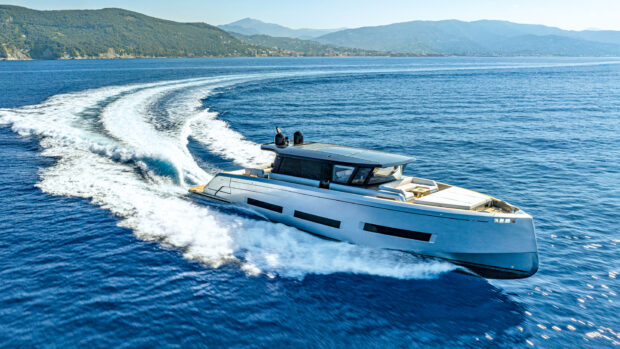Trawler hardiness and stylish glamour become happy bedfellows aboard Azimut’s tri-cabin winner.
‘The Range Rover of the seas’ declares one of Azimut’s promotional leaflets.
It’s a good starting point to try and categorise a boat that is far from a typical trawler.
The Magellano 43 may have that quintessential stoic trawler sturdiness underneath but it possesses all the opulence of its more mainstream Azimut siblings too.
And that’s not just in its sumptuous Carlo Galeazzi-designed interior.
Outside too, although poles apart from its sleek sportscruiser relations, this Cor D Rover-styled trawler feels just as classy and expensively crafted, clearly more Range Rover than Land Rover.
The Range Rover analogy doesn’t end there either. Like its two family members (Magellano 50 and 76) the 43 is not the aquatic equivalent of a high-speed sportscar designed for the perfectly smooth conditions of a track day.
Instead, this cruiser utilises what Azimut calls its Dual Mode hull, designed to provide a soft ride through the rough and tumble of challenging seas.
Like its automotive counterpart, the 43’s 22-knot pace is moderate, not neck snapping.
The court of public opinion has frequently judged the Range Rover to be top of its class.
So how does the Azimut Magellano 43 fare in its watery arena?
Smooth & unslammable
While Britain was contending with biblical rain during November last year, we sneaked off to Italy to be greeted by surreal weather.
Although we had all been praying for monster waves to test the 43’s mettle, we found 20°C and bright sunshine around our base of Varazze.
Fortunately, heading well out to sea brought us into contact with enough of a choppy swell to get a proper feel of the 43.
The most obvious trait this Bill Dixon-designed hull possesses is a steadfast refusal to slam.
Despite my best efforts, such as deliberately leaning the 43 over the wrong way as I crossed the wake of the photo boat, I couldn’t even elicit the muted thumps that can help indicate a sound structure.
After three hours on the water, I returned without a single teeny thud to my credit.
Although monster waves evaded us, I’m reasonably certain this smooth ride would continue in the worst conditions.
While its nose does trim up a little as speed increases, in general the 43’s semi-displacement hull form stays firmly planted in the water – it tends to cleave the waves aside rather than skipping across their tops.
My feeling is that skippers would have to drive the 43 recklessly hard into steep head seas before they managed to launch the sharp forward sections clear of the water.
Lock to lock
Driving downwind, further out to sea in the bigger waves, there were times when I thought the 43 felt a little vague. I reckon this is due to the steering.
Azimut generously fits hydraulic power steering to the 43 as standard – highly unusual on a boat this size – but it is set up with six turns lock-to-lock.
So although the steering is light, it takes a lot of wheel spinning to achieve a useful response.
It’s always been a mystery to me why any boat needs more than two or three turns lock-to-lock (if your Range Rover had six, you’d send it back).

Simple wiper controls are straightforward to operate, and they power three strapping pantograph wipers.
Under way, the 43’s hull only trims to a maximum of 4.0°, a low figure that helps provide the helmsman with a clear view out and over the bow at any speed, despite this boat’s bulwarks.
Three reassuringly chunky pantograph wipers are fitted, and the elongated eyebrow over the front screens keeps glare at bay.
My only concern is the dark tint on the side windows and front screens. In the bright sunny conditions we encountered they appeared far less tinted from inside the saloon, but it’s hard to believe that they would not impede the safe view out under gloomy skies.
Up close & personable
Like most trawlers, the 43 is not a svelte boat. Yet despite its height and its windage, I found it particularly docile when manoeuvring around the confines of our marina.

The mast is fixed on the flybridge 43, but on the hardtop 43 it hinges to reduce air draught to 11.5ft.
The gearboxes are blessed with super-smooth gear engagement, the throttles are very slick, and there’s plenty of kick from the optional bow thruster.
The view from the flybridge helm is terrific, and the single central upright mast impedes the panorama far less than a broad goalpost mast would.
Azimut has also contrived a very clear view of the bathing platform through the flybridge hatch, which is a boon for helmsmen mooring stern-to in the Mediterranean, or even alongside a pontoon.

Plenty of room for clobber at the fl ybridge helm, with two fi ddled shelves to the helmsman’s right.
The 43’s stern mooring gear is excellent too and all adds up to a boat that should be very easy to handle in and out of the marina, even in a tight spot and tricky conditions.
Driving the Azimut Magellano 43
To make sure that the 43’s unusual hull shape performed as effectively as possible, Azimut built a full-size 43 and ballasted it to the correct displacement, including building a gantry so the weight could be sited in the correct vertical position.
Then Azimut trialled the hull extensively and fine tuned the hull shape: chines and tunnels and so on.
Fitted with the 355hp Cummins QSB5.9, we achieved 22.4 knots flat out.

Darkly tinted screens are likely to impair the safe view out at night and in gloomy conditions.
This with five crew, half the 43’s fuel and water, but no tender, liferaft or cruising stores on board.
Our prototype props were pulling the required revs, but this left the engines slightly under-loaded at 96%.
So with better props, Azimut’s claim of 22 knots seems realistic for a Magellano 43 with 50% fuel and water and a generous assortment of cruising stores.
Rival figures
There does seem to be a price to pay for the 43’s luxurious interior and sturdy build quality though.
Weighing 13.6 tonnes in its empty state, it’s over 23% heavier than Bénéteau’s Swift Trawler 44 and on the water the difference feels greater still.
So the 22.4-knot top speed its 355hp diesels provide is down on the sprightly 24.8 knots that the lighter French trawler achieves with its 300hp Volvos, representing a roughly 30% difference in fuel efficiency.
There is a less powerful engine option, the 305hp version of the QSB5.9.
Using that 22-knot estimate as a benchmark, these should give 20+ knots flat out, more than the modest 18 that Azimut is claiming.
However, as the 305hp and the 355hp are the same 5.9-litre diesels with different ratings, they will most likely burn virtually the same amount of fuel at any given hull speed.
So there seems little point picking the 305hp engines and losing two potential knots unless the small price difference is make or break.
Engine access is via a hatch in the galley or cockpit and the engineroom is spacious, though I’d be inclined to increase the lighting here.
Do treat yourself to Racor’s excellent dual fuel filters (a £1,800 option), complete with clear inspection bowls.
Trawler glamour
Carlo Galeazzi always seems to dish up opulent interiors, and the Azimut Magellano 43 is no exception.
But this is not the only characteristic that makes the 43 stand out.

Shelving in guest cabin provides lots of easily accessible storage.
Its third cabin may only sport a large single berth, but how many 43-footers can offer more than two cabins anyway?
In its optional form, arranged as a huge storage area, this will be a boon for long-distance cruising types.
Likewise, the 43’s owners will appreciate their larger than average ensuite. The saloon seating is comparatively palatial too.

Owner’s cabin sports twin wardrobes and lots of shelving too.
For a long-range cruiser though, the galley is marginal.
Galley-up arrangements customarily trade the scarcity of eye-level lockers (the 43 only has one) in exchange for numerous other benefits.
With the big folding dining table and the sideboard close by, the 43’s limited countertop may be no big deal for some.
However, my guess is that avid chefs will want to annex most of the stowage in the saloon to bring the levels of storage up to scratch.

Sliding window alongside galley provides plenty of fresh air.
Arranging the two galley lockers as four big drawers, and providing a cutlery drawer, would have improved matters no end.
Deck storage is better. Azimut has utilised every nook and cranny in the cockpit and on the flybridge.
The bathing platform is large enough for a good tender, and although the 43 has no lazarette (as most trawlers do) there’s potential for a liferaft plus other lengthy and bulky items to be housed in bespoke storage boxes at the aft end of the roomy flybridge.
A closer look at the Azimut Magellano 43 with Dave Marsh
Foredeck details
The 43 has a sizeable sunpad for this size of boat. The head also hinges to provide a comfy backrest.
Tall bulwarks and exceptionally sturdy guardrails make the foredeck a very safe place, yet they don’t intrude on the helmsman’s view out from inside.
Third cabin options

Third single-berth cabin can be arranged as a giant storage room.
A third cabin is a big bonus on a 43-footer, and it can be set up with a single berth, or laid out as a giant storage area (as shown here) with generous shelving and Azimut’s portable storage bags, which are great for carrying stuff ashore.
Flybridge details
Sturdy handrails are a usefully tall 32in (810mm) and the wraparound handrail on the central mast is an excellent safety aid in choppy conditions.
The comfy flybridge seating converts easily into a sunbed. The helmsman’s view from the flybridge is excellent.
The engineroom

The engineroom needs more fixed lighting than its single strip light.
There are two ways in: via the cockpit hatch, or through the large hatch in the galley.
With both hatches open, even with the optional 11kW generator installed, access to most of the machinery is very good indeed.
The engineroom needs more fixed lighting than its single strip light, although Azimut’s usual invaluable wandering light does help matters.
Azimut Magellano 43 verdict
It’s not unusual for boats in the trawler category to have distinct personalities.
Can you think of anything which is close in character to an Elling E4, or Hardy’s 42, or a Grand Banks 41? And so it is with the Azimut Magellano 43.
Cor D Rover has created a unique external style. Inside too, no other boat functions quite like the 43.
There’s one more cabin than you’d expect. It sports a bigger than average owner’s heads.
Its compact galley is positioned adjacent to the cockpit.
And let’s not forget that it comes in hardtop form too, not just in the flybridge incarnation we tested.
Most of all, it simply doesn’t feel like a trawler normally does inside, it feels more like a glamorous 35-knot sportscruiser.
Rather like a Range Rover, it has a luxurious opulence which belies its rugged underpinnings.
So how you weigh its price is tricky; it’s inexpensive compared with the Hardy 42 but pricey compared with Bénéteau’s Swift Trawler 44.
But then, Range Rovers aren’t exactly cheap, are they?
First published in the January 2013 issue of MBY.
Price as reviewed:
£1.00
Details
Price from: approx £437,000 (twin 355hp)
Price as tested: approx £515,000 (twin 355hp)
11kW generator (option on test boat): £13,400
40,000 Btu air-con (option on test boat): £22,480
Bow thruster (option on test boat): £4,760
Dual Racor fuel filters (option on test boat): £1,800
Raymarine C125 navigation (option on test boat): £12,630
Passarelle (electric) (option on test boat): £12,330
Length overall: 44ft 9in (13.63m)
Beam: 14ft 5in (4.40m)
Fuel capacity: 370 imp gal (1,680 litres)
Water capacity: 132 imp gal (600 litres)
Draught: 3ft 11in (1.20m)
RCD category: B (for 12 people)
Designers: Azimut & Bill Dixon & Cor D Rover
Displacement: 13.6 tonnes (empty), 15.6 tonnes (full fuel & water)
Test engines: Twin Cummins QSB5.9. 355hp @ 2,800rpm. 6-cylinder 5.9-litre diesels









